This post may contain affiliate links. Please read our disclosure policy.
These gluten free blueberry scones are tender and flaky inside, with a lightly crisp top. And you can turn them vegan with just a couple of tweaks. But just as they are—bursting with fruit and luscious flaky, crumbly pastry—these are gluten free scones the whole family will love.
If you’re looking for a base recipe to make gluten free scones in any flavor—like chocolate chip, citrus, or classic vanilla—try my easy gluten free scones for every flavor recipe.
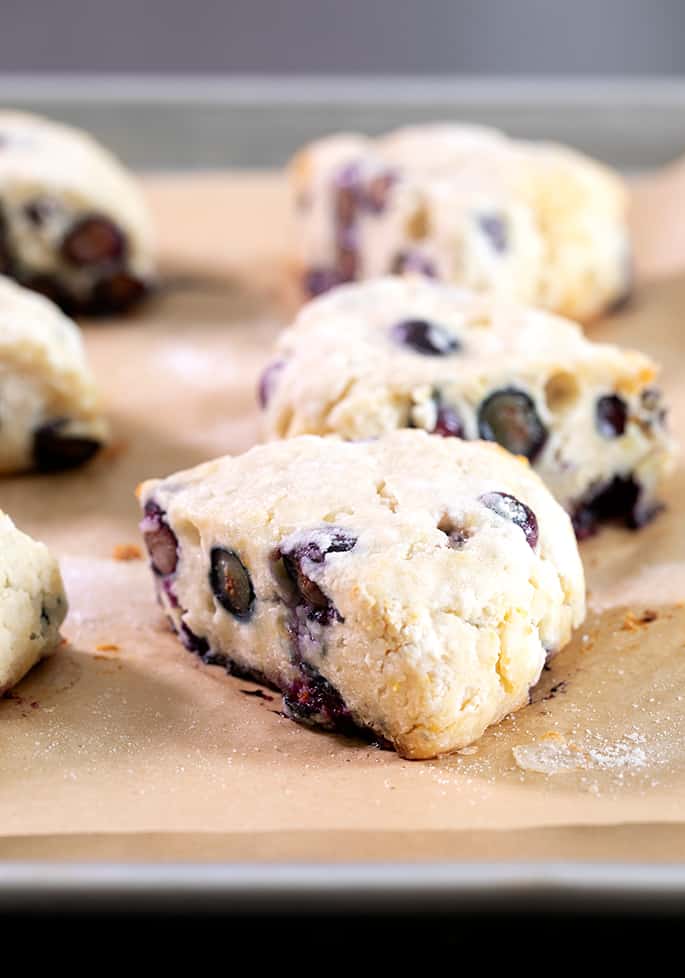
Why this is the best recipe for gluten free blueberry scones
The best gluten free baked scones are both buttery and moist, but pleasantly crumbly. The right recipe, like this one, has the perfect balance of cold, wet ingredients like butter and milk to keep that crumb tender, and enough flour to keep them from being squishy, like a muffin or other cake.
When you're making not just “regular” gluten free scones, but blueberry scones, you're introducing more moisture into the mixture. We want those blueberries to add texture and flavor without making our pastries weepy. This recipe does just that.
Key ingredients
- All purpose gluten free flour – I like to stick with my old standby all purpose gluten free flour here, Better Batter (and of course you can always use my mock Better Batter). It makes these scones sturdy enough to be crisp-tender without ever falling apart before you break into one.
- Cornstarch – Added cornstarch helps lighten the scones and make them more tender. If you're using a higher starch all purpose gluten free flour blend, like Cup4Cup, don't add more cornstarch; instead, replace the cornstarch with more Cup4Cup.
- Baking powder and baking soda – These are the chemical leaveners that are responsible for most of the lift in these beautiful blueberry scones. Make sure yours are fresh by checking the date on the canisters.
- Salt – Salt brightens and enhances the other flavors in these mildly sweet scones. I always bake with kosher salt, or lightly flaked sea salt, since they're easier to measure without mistakenly overmeasuring.
- Sugar – There's just a touch of granulated sugar in these scones, but the sweetness comes mostly from the blueberries. Scones are special, in part, because their flavors are more delicate, and the added sweetener is no exception.
- Lemon zest and juice – Adding lemon zest and lemon juice doesn't really make these into gluten free lemon blueberry scones; the added lemon is just enough to help brighten and complement the gentle sweetness and flavor of the blueberries.
- Butter – The butter in these scones is chopped and kept super cold and distributed evenly throughout the rest of the dough. That's so that, when the scones hit the heat of the oven, the butter expands and creates the scones' characteristic flakiness.
- Blueberries – You can use fresh or frozen blueberries here, but make sure they're sweet! If you have a choice between fresh early-season blueberries that are kind of tough and sour or frozen berries, use frozen.
- Milk – Like the butter, your milk must be kept cold. Otherwise, it will melt the butter and keep the scones from becoming flaky. Avoid nonfat milk, which robs the scones of richness.
- Honey – Just a touch of honey in these scones adds a bit more sweetness and a subtle depth of flavor to the finished pastries.
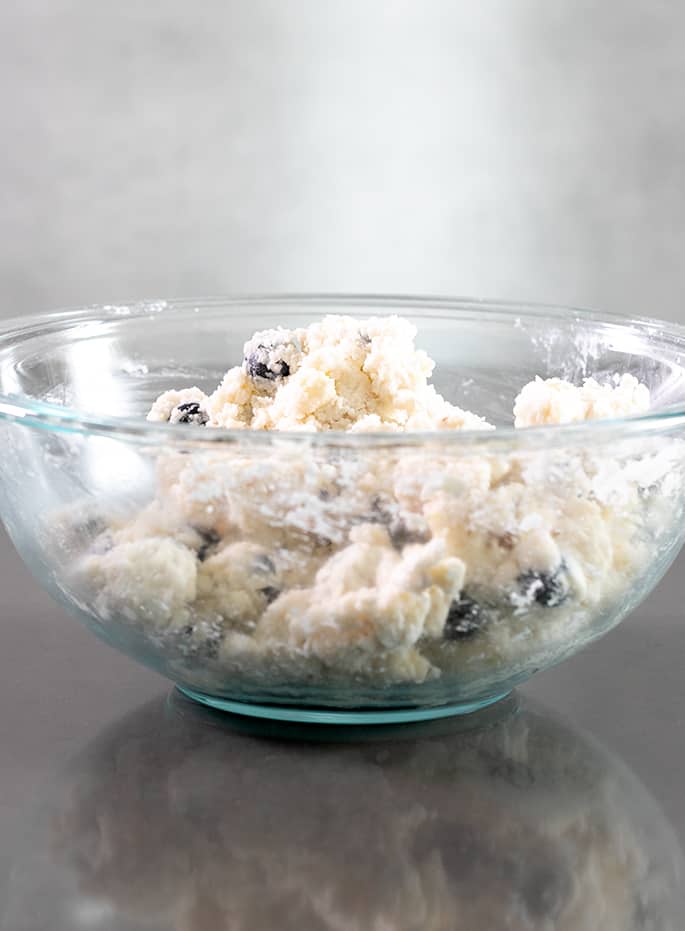
How to make gluten free blueberry scones
Now that we know what I even mean when I call a recipe “gluten free blueberry scones,” perhaps you'd like to know how to make them. This being a recipe blog and all.
These scones are easily made in one single mixing bowl. The prep time is just about 10 minutes of active time, with a short spell in the freezer for the dough before it's sliced.
In a large bowl, you'll mix the dry ingredients (gluten free flour, baking powder, baking soda, salt, plus a small bit of granulated sugar), then add chunks of cold butter (see below for how to make this dairy-free) and flatten them in the dry ingredients. Flattening the butter once it's in the dry ingredients keeps it from melting too quickly in your hands, or in the oven.
I also like to add lemon zest to the dry ingredients. Lemon flavor goes so beautifully with blueberries and brightens the whole recipe. Next, you'll toss in the fresh blueberries and stir gently so you don't break the berries. Medium-sized berries work best, as they hold their shape but don't overwhelm any individual scone.
Finally, the wet ingredients (milk, lemon juice and honey) are added into a small well you'll create in the dry ingredients. Be sure to mix gently and don't handle the dough too much. You want the ingredients to stay cold, so the butter melts suddenly in the oven and not a moment before.
All that's left to do is shape the dough into a disk, cut it into 6 triangles, brush the tops with milk and cover with a bit more sugar. The milk and sugar topping helps the tops of the scones brown a bit more in the oven without overbaking the rest of the scones.
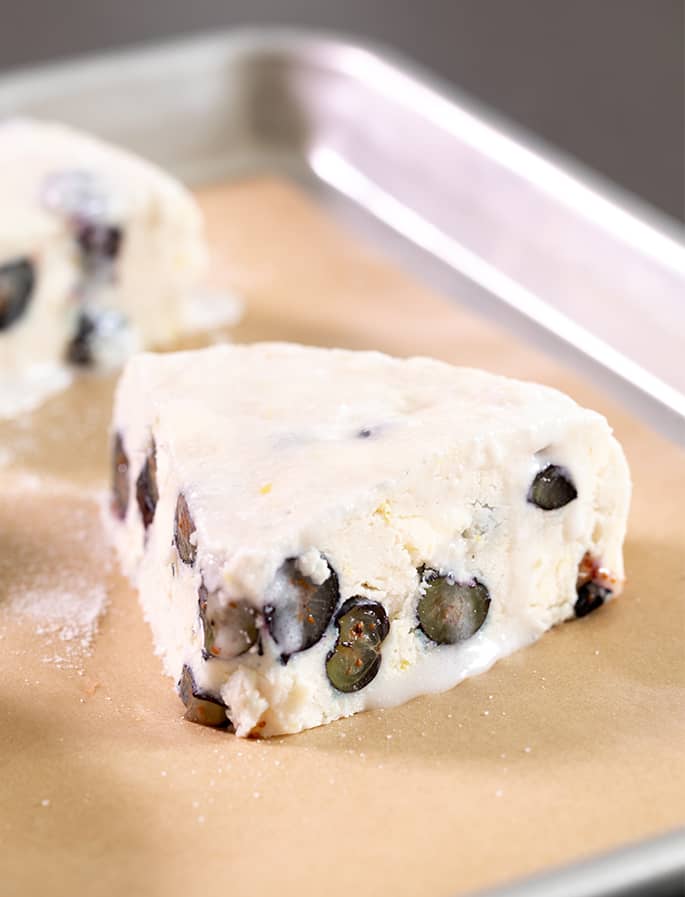
Expert tips
You shouldn't have any trouble making these gluten free scones if you follow my simple recipe, but there are a few tips that can help guarantee your success.
Use chunks of very cold butter
Many recipes recommend that you use a pastry cutter or other metal utensil to break the cold butter into “pea-sized pieces.” That often leads to tough pastries, though, since such small pieces of butter will often melt when you handle them at all.
Instead, I prefer to chop the fat into chunks, keep the butter extremely cold, toss the butter in the dry ingredients and then flatten it between my thumb and forefinger. That way, the pieces of butter don't clump together, and remain evenly distributed throughout the dough so they are well-positioned to expand in the oven and create flakiness.
Shape carefully
Shape your scones by using a light touch, pressing the dough together just until it holds, but without warming it up. If there are sticky parts, dust your hands lightly with more gf flour as you go.
Cool completely
When your scones first come out of the oven, they'll be a bit fragile. Let them cool completely before you attempt to transfer or handle them, since they'll firm up and become really stable once cool.
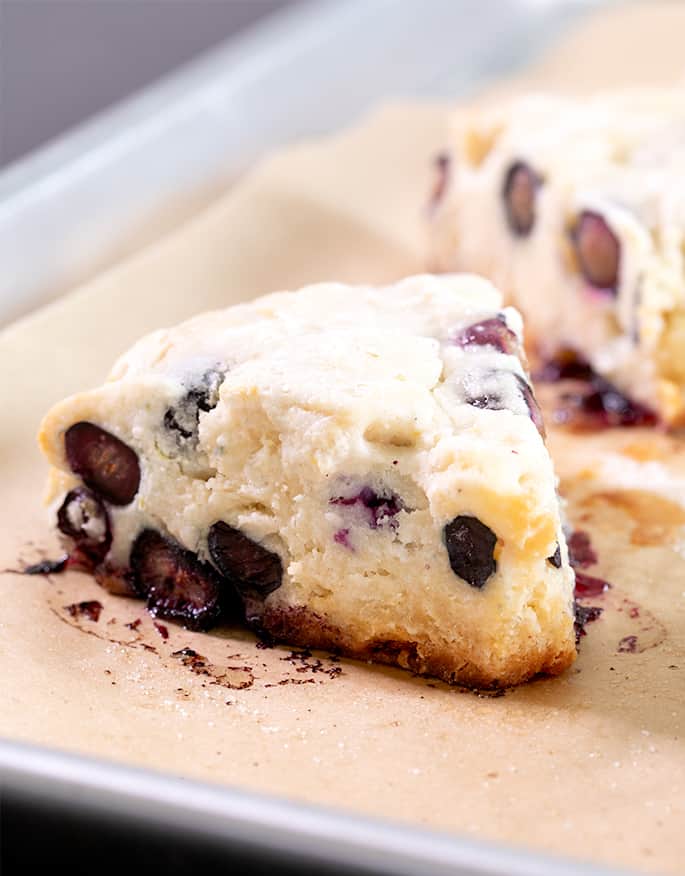
Ingredient substitutions
Dairy free
I have successfully made these gluten free scones dairy-free (and vegan) by replacing the butter with Miyoko's brand cultured vegan butter (which my local Trader Joe's now carries!) and with Melt brand vegan butter. I think it would also work with virgin coconut oil, but the scones won't puff up quite as much.
For the milk, I used unsweetened coconut milk in the carton, which is great for nondairy milk for cooking and baking. Its flavor is relatively neutral and it has enough fat to help baked goods brown. My other favorite nondairy milk for baking is unsweetened almond milk.
In place of honey (to make the scones vegan), use Lyle's Golden Syrup or light corn syrup. Either one will work just fine.
Vegan scones
Follow the suggestions above to replace the dairy, and in place of honey, use Lyle’s Golden Syrup or light corn syrup. Either one will work just fine. Be sure that the granulated sugar you use is free of bone char.
Fresh or frozen blueberries?
Find yourself some really nice frozen blueberries, and you can use them in this recipe in place of fresh. But don't defrost them!
Whatever precautions you take, the blue color will bleed into the batter. But if you defrost the berries, they'll get crushed in the batter no matter how careful you are—and they'll bleed even more.
I think this recipe would also work great using raspberries. If you'd like to make strawberry scones, that really requires a different recipe as strawberries have a ton more moisture. Try my recipe for strawberry shortcake biscuits, and shape them into scones instead of biscuits.
Cornstarch alternative
“Cornstarch” in the U.S. is also known as corn flour, and it's just a finely milled starch. If you need to make this recipe corn-free, the cornstarch can easily be replaced with arrowroot.
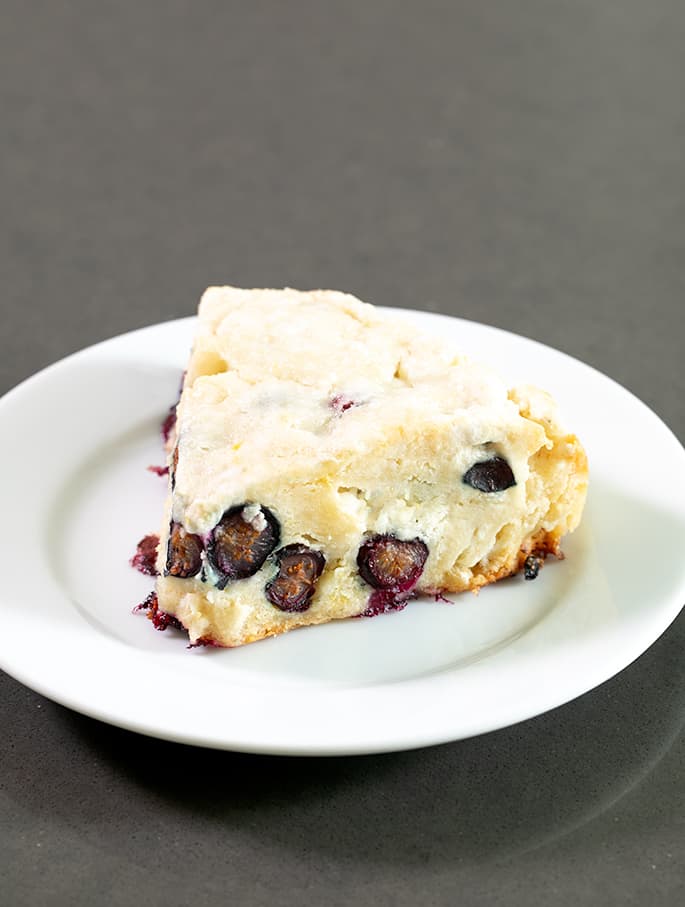
Gluten Free Blueberry Scones Recipe
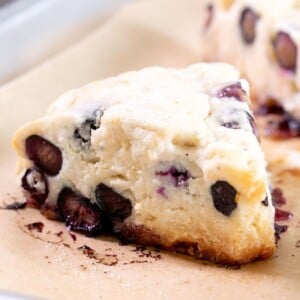
Ingredients
- 1 ¾ cups (245 g) all purpose gluten free flour blend, plus more for sprinkling (I used Better Batter; click thru for appropriate blends)
- 1 teaspoon xanthan gum, (omit if your blend already contains it)
- ¼ cup (36 g) cornstarch
- 2 teaspoons baking powder
- ¼ teaspoon baking soda
- ½ teaspoon kosher salt
- 2 teaspoons (12 g) granulated sugar, plus more for sprinkling
- Freshly grated lemon zest from 1 medium lemon
- 5 tablespoons (70 g) unsalted butter, chopped into small chunks and chilled
- 1 cup (180 g) fresh blueberries
- ¾ cup (6 fluid ounces) milk, plus more for brushing
- 1 tablespoon freshly squeezed lemon juice
- 2 tablespoons (42 g) honey
Instructions
- Preheat your oven to 400°F. Line a rimmed baking sheet with unbleached parchment paper and set it aside.
- In a large bowl, place the flour, xanthan gum, cornstarch, baking powder, baking soda, salt, granulated sugar, and lemon zest, and whisk to combine well.
- Add the chopped and chilled butter, and toss to coat it in the dry ingredients. Flatten each chunk of butter between your thumb and forefinger.
- Add the blueberries, and toss to coat.
- Create a well in the center of the dry ingredients and add the milk, lemon juice, and honey. Mix gently until the dough begins to come together.
- If necessary, press together into a dough with floured hands, handling the dough as little as possible.
- Turn out the dough onto a large piece of plastic wrap and press into a disk that’s about 7 inches in diameter.
- Wrap the disk tightly in the plastic wrap and place in the freezer to chill for about 10 minutes or until firm.
- Remove the dough from the freezer, unwrap it, sprinkle the top with about 1 teaspoonful additional flour and spread out over the top of the disk.
- Using a large, sharp knife or a bench scraper, cut the dough into 2 equal halves, then each of those halves into 3 equal triangles.
- Place the wedges about 2 inches apart from one another on the prepared baking sheet, and using a pastry brush, paint the tops generously with milk. Sprinkle the tops generously with granulated sugar.
- Place the baking sheet in the center of the preheated oven and bake until the scones are puffed, very pale golden all over and slightly more brown on the edges and top (about 20 minutes).
- Remove from the oven and allow to cool for 10 minutes or until firm on the baking sheet before serving.
Video
Notes
Nutrition information is automatically calculated, so should only be used as an approximation.
Storage instructions
Short term: With the perfect balance of moisture and crisp-tenderness, these gluten free blueberry scones actually last quite well for up to 3 days at room temperature. Just wrap them tightly, individually, and keep them at cool room temperature. You can even refresh them in the toaster over after sprinkling lightly with water first.
Long-term: Once they're baked and cooled, you can freeze wrap them tightly in a freezer-safe wrap like Glad Press n Seal, and freeze.
Make-ahead: Make and shape the raw scones, then store the shaped wedges in the freezer, wrapped tightly. Bake right from frozen after brushing with milk and sprinkling with sugar. Another few minutes in the oven may be necessary, but not much.
FAQs
One of the most common reasons for gluten free blueberry scones (or any gluten free scones) not rising is that the baking powder isn't fresh. Either it's been open too long or it's expired.
The gluten free flour blend I like best here is a combination of Better Batter gluten free flour with an added helping of cornstarch to lighten it a bit. You could also use a full 2 cups (280 g) of Cup4Cup gf flour blend in place of both.
Because this recipe calls for lemon juice and zest, and since buttermilk can be a more difficult ingredient to keep on hand, this recipe was developed without calling for buttermilk. You only need regular milk, instead, for ease.
Measure your ingredients carefully, by weight, so your moisture balance is right
Keep your ingredients cold, and shape using a light touch so the butter chunks stay intact and don't begin to melt until the scones are in the oven
Cut your scone wedges at a right angle to the surface they're on using a bench scraper or sharp knife in a swift motion for a sharp edge
Chill your shaped scones until they're firm before putting them in a fully preheated oven, and no peeking!
Use fresh baking soda and baking powder
Did you use a poorly-balanced all purpose gluten free flour blend, like one of King Arthur Flour's blends? They will dry out your baked goods. Otherwise, be sure to measure by weight, not volume, whenever possible for precise, accurate measurements, and don't make substitutions unless absolutely necessary.
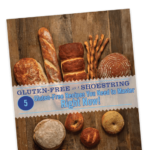
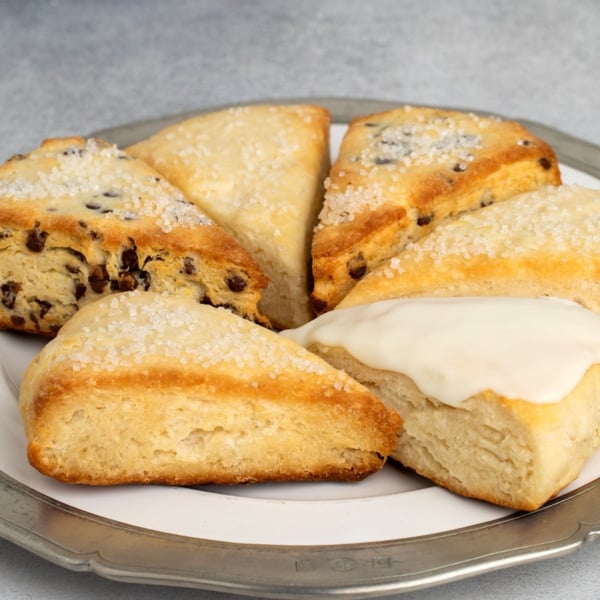
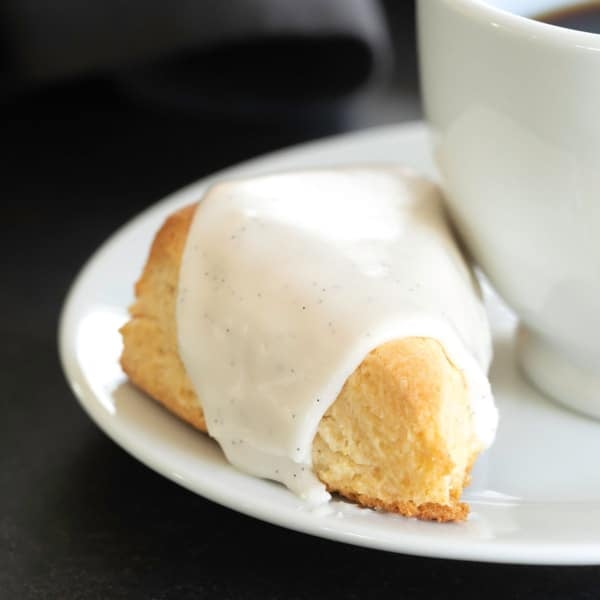
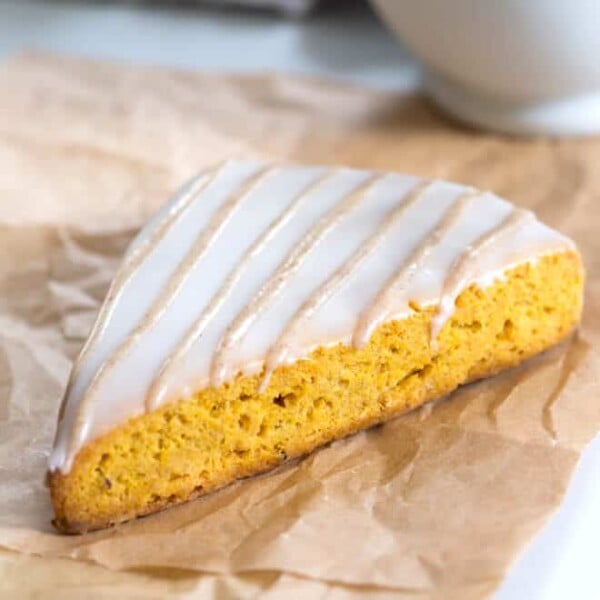









Made these scones this afternoon. They are so delicious. I use the gluten-free flour from Costco. I put a lemon glaze on top when they had cooled.
I’m so glad the scones worked well for you, Carolyn. Thanks for sharing your experience!
Hi Nicole,
Will these scones work if I substitute the milk for a plant based milk? Also, is there a replacement for the cornstarch?
I love scones but haven’t been able to find a recipe that works for me.
Thanks,
Brenda
Hi, Brenda, please see the text of the post under the heading “ingredients and substitutions” for answers to both of your questions!
I’m not much of a baker ( more of a cook). This was a little complicated for me, and my scones didn’t look as pretty as yours, but they were delicious with coffee for breakfast! I am trying to summon the courage to try pizza and bagels, which I very much miss as a native New Yorker.
Thanks so much for providing these wonderful recipes for all of us!
I’m so glad you had success with this recipe, and if you are willing to follow a recipe closely, you can bake—as you can see! And I only have to make them look pretty because I’m taking pictures of them, Stephanie! Give yourself all the credit in the world…
Thank you Nicole and thank you for sharing your wonderful recipe!
If I may, one more question regarding gluten free flour blends. I’m new to baking, and gluten free flour blends. We just visited Seattle last week and the famous Pike’s Market. To my surprise I found a bakery selling beautiful gluten free goods. One was a delicious blueberry lemon scone somewhat similar to your recipe. They said they used Bob’s Red Mill all purpose GF flour (the one with chick and fava beans). I was surprised about the beans but it tasted good to me and my hubby. Will this type of flour work in your recipe if I add the xanthan gum or psyllium husk powder? I like the idea of protein in a gf flour for nutrition if it works.
I’m afraid I recommend against that blend, Haleema. When I first started baking gluten free over 20 years ago, I started with a bean flour blend similar to that one (created by the late great Bette Hagman), and it was very very limiting. You need a very strong competing flavor to cover the bean aroma and flavor, and it often doesn’t work.
Can these be sweetened with maple syrup instead?
Most of the sweetener in these scones is actually in the form of honey, Haleema. If you’d like to replace the 2 teaspoons of granulated sugar, you can add another teaspoon of honey and leave out the granulated sugar.
Hi Nicole,
Can these scones be made ahead and frozen?
Hi, Linda, yes, you can freeze them baked or unbaked. For instructions, please see the text of the post under the heading “Freezing gluten free blueberry scones”
This was a really easy and successful recipe!
Note: I modified to make these cranberry scones, with 1:1 substitutes for fresh cranberries instead of blueberries and orange juice instead of lemon juice. I also subbed Brown sugar in lieu of granulated sugar for the topping.
I used cup 4 cup, which means I replaced the corn starch with more flour, as instructed.
The one thing I would say that caught me off guard was that they were a lot thicker as a 7inch round than scones I used to make pre-celiac (they were easily an inch thick pre-bake, where my old scone recipe instructed to gently roll out to 1/2 inch). Seeing someone say that their scones didn’t cook, I erred on the side of the familiar and (gently) rolled it into a rectangle that was 1/2 inch thick, then cut into triangles. I also used brown sugar instead of granulated sugar on the top. I proceeded with the bake as instructed and they were wonderful! It’s possible they would have been just as good or better had I left them as a 7” round, 1 inch thick, but I was worried they were too thick.
Not for Author: can you add how thick they should be pre-bake to the recipe? That would have improved my confidence about how things were going during the recipe.